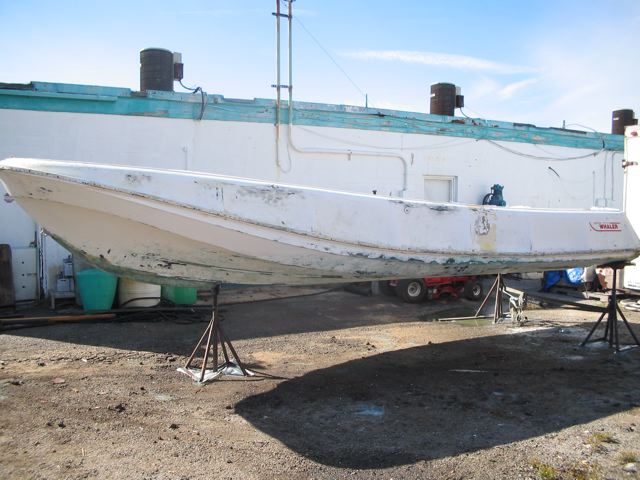


1972 Boston Whaler Outrage 21 Restoration
Deconstruction - Phase I
(continued from original webpage)
October 30, 2006
Thanks to Tidewater Soda Blasting our "Grand Dame" got blasted. Robert May, retired Naval pilot & chief soda blaster, removed as many layers as could safely be removed with a high pressure application. He was able to take it right down to the blue-green glass in a few spots. However, much to everyone's surprise, there were still more layers of paint/gel-coat/paint covering much of the vessel. It quickly became apparent that she was in need of supplemental cosmetic surgery - an emergency facial peel was in order!!!
|
|
Facial peel courtesy of Bix Tough Job Remover Cruel to be kind! |
The good news: I was a silently worried because, upon arrival, the boat was... well, kind'a lumpy. I dared not to reveal such thoughts to my husband because he is highly prone to hysteria, and since it was my idea to grab this particular boat - I didn't want to acknowledge any doubt. At first, I was thinking it was gonna take a heck of a lot of fairing/sanding to straighten it out - and that's if it could be straightened out. But, thanks to Bix Tough Job Remover (Home Depot $18.98gal "Outstanding for marine applications!"), we have finally gotten to the bottom of the situation. And much to my relief, at the bottom exists a fairly nice, smooth well-shaped hull. Note: Bix leaves a yellowish stain on the fiberglass which comes right off w/ a little hose water.
Now I'm confident that, with a fresh coat of Awl-Grip oyster white sprayed on, this boat will look like a million bucks!
_____________________________________________________________
April 30, 2008: After a long wet winter, we have come back to this project: begun fairing & sanding. We sanded down the spider-cracks & repaired the misc. holes cut in the gunnels/deck w/ cloth & epoxy resin. For fairing over our repairs, we are using 3M Premium Marine filler (vinyl-ester) and cavasil. We are going to prime w/ some high build, sandable primer before spraying the whole hull w/ Awl-Grip.
Finishing a restoration is a lot like building a new boat in that, at some point, one has to decide when to stop sanding. A charter boat Capt friend of mine once said he paid $100,000 for sanding (re: the last boat he had built by Jarrod Bay). After doing 2 restorations, I believe him. The amount of finish sanding can have a significant impact on the overall cost of a project. It's almost like there's a happy median that has to be found.
As usual, comments, advice and/or suggestions are most welcome!
______________________________________________________________________
Life's rich pageant marches on...
Wili & Harry Engel